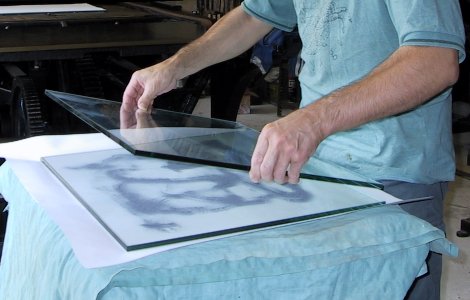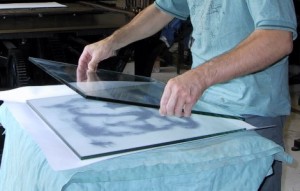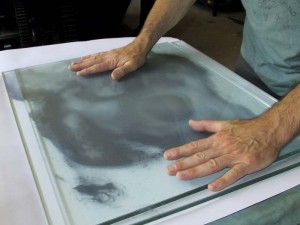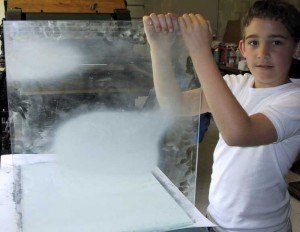
 Whatever is your choice, never to leave lively the superior edges of glass, to protect rollers. The superior surface of glass, the one who has to receive the sensitive coat, has to undergo also a preparation. She must be flatten and doucie to be able to support the sensitive layer, to offer a ” fine adhesive basis ” for gelatin which does not adhere naturally to the glass. For that purpose, we rub glass two by two, the one against the other one with some water and an abrasive powder, so as to roughen all the surface. After diverse tests, I retained the process consisting in using the current product getting closer most to the old flower of emery ( natural corundum), that used dry or with a little water of the powder of silicon carbide – grains 150 to grinding from 400 for the finish (on sale at the suppliers
Whatever is your choice, never to leave lively the superior edges of glass, to protect rollers. The superior surface of glass, the one who has to receive the sensitive coat, has to undergo also a preparation. She must be flatten and doucie to be able to support the sensitive layer, to offer a ” fine adhesive basis ” for gelatin which does not adhere naturally to the glass. For that purpose, we rub glass two by two, the one against the other one with some water and an abrasive powder, so as to roughen all the surface. After diverse tests, I retained the process consisting in using the current product getting closer most to the old flower of emery ( natural corundum), that used dry or with a little water of the powder of silicon carbide – grains 150 to grinding from 400 for the finish (on sale at the suppliers  of material for the work of the stone), According to the same technique of the rubbed glass the one on the other one until obtaining of one frosted very fine and exempt from any irregularity (for it, to wipe from time to time the white powder which is the product of the abrasion of the glass when we work dry, and to put hand a little new powder before rubbing again). Well rinse in the water patches in every change of grain to avoid stripes.
of material for the work of the stone), According to the same technique of the rubbed glass the one on the other one until obtaining of one frosted very fine and exempt from any irregularity (for it, to wipe from time to time the white powder which is the product of the abrasion of the glass when we work dry, and to put hand a little new powder before rubbing again). Well rinse in the water patches in every change of grain to avoid stripes.
 Hollow of glass resulting own irregularities must be made up during the first phase (with the biggest grain). More the surface of glass is big, longer will be this operation. This process to require no particular equipment, and to be little expensive. Other solutions can be used to obtain the frosted, such as the sanding in the machine (mechanical projection by compressed air of fine sand), or the use of fluorhydric acid . Being the latter of an employment dangerous for the concentrated state, it is not advised. These last two solutions have certain inconvenience not to flatten the glass, that is not to correct the irregularity of their surface. It is indeed important to note that the crude glass have no perfectly flat surface, and these imperfections concerning their thickness can vary of the order of several tenth of millimeters.
Hollow of glass resulting own irregularities must be made up during the first phase (with the biggest grain). More the surface of glass is big, longer will be this operation. This process to require no particular equipment, and to be little expensive. Other solutions can be used to obtain the frosted, such as the sanding in the machine (mechanical projection by compressed air of fine sand), or the use of fluorhydric acid . Being the latter of an employment dangerous for the concentrated state, it is not advised. These last two solutions have certain inconvenience not to flatten the glass, that is not to correct the irregularity of their surface. It is indeed important to note that the crude glass have no perfectly flat surface, and these imperfections concerning their thickness can vary of the order of several tenth of millimeters.